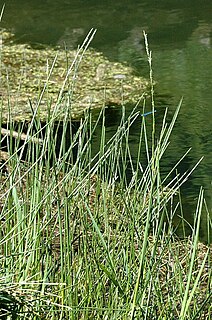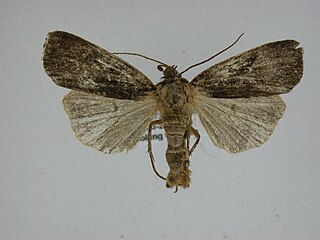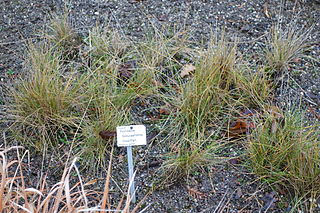
The grove snail, brown-lipped snail or Lemon snail is a species of air-breathing land snail, a terrestrial pulmonate gastropod mollusc.

Molinia, or moor grass, is a genus of two species of flowering plants in the grass family, native to damp moorland in Eurasia and northern Africa. They are both herbaceous perennial grasses.

Poa nemoralis, the wood bluegrass, is a perennial plant in the family Poaceae. The late-growing grass is fairly nutritious for livestock, which feed on it in the autumn, and it is used as a lawn grass for shady situations.
The elm cultivar Ulmus 'Nemoralis' was listed by Schelle in Beissner et al. (1903), as U. campestris f. nemoralisHort. Considered "possibly U. carpinifolia " by Green.

Glyceria is a widespread genus of grass family common across Eurasia, Australia, North Africa, and the Americas.

Glyceria striata is a species of Glyceria which is known by the common names fowl mannagrass and ridged glyceria. It is native to much of North America, from Alaska and northern Canada to northern Mexico.

Kyllinga is genus of flowering plants in the sedge family known commonly as spikesedges. They are native to tropical and warm temperate areas of the world, especially tropical Africa. These sedges vary in morphology, growing to heights from 2.5 centimeters to a meter and sometimes lacking rhizomes. They are closely related to Cyperus species and sometimes treated as part of a more broadly circumscribed Cyperus.

Glyceria fluitans, known as floating sweet-grass and water mannagrass, is a species of perennial grass in the genus Glyceria native to Europe, the Mediterranean region and Western Asia and occurring in wet areas such as ditches, riverbanks and ponds.

Oeneis jutta, the Jutta Arctic or Baltic grayling, is a species of butterfly in the subfamily Satyrinae with a Circumboreal distribution. It occurs in bogs and tundra in the north of Europe, the Baltic states, the Urals, Siberia, northern Kazakhstan, the Russian Far East, northern Mongolia, northeastern China, North Korea, and northern North America. Larvae feed on Carex and Eriophorum, possibly also Glyceria, Molinia, and Juncus. Ledum palustre is the preferred nectar plant of the adult butterflies. The species has one generation every one or two years, depending on the location.

Catabrosa is a small but widespread genus of plants in the grass family native to temperate areas of Eurasia, the Americas, and a few places in Africa.

Solidago nemoralis is a species of flowering plant in the family Asteraceae. It is native to North America, where it is widely found in Canada and the United States. Its common names include gray goldenrod, gray-stem goldenrod, old-field goldenrod, field goldenrod, prairie goldenrod, dwarf goldenrod, and dyersweed goldenrod.

Pseudohermonassa bicarnea, the pink-spotted dart, is a moth of the family Noctuidae. The species was first described by Achille Guenée in 1852. It is found in eastern North America, and as far west as south-central Saskatchewan and central North Dakota, south to western North Carolina. It has recently been recorded from Tennessee.

Elachista apicipunctella is a moth of the family Elachistidae found in Europe. It is found in all of Europe, east into northern Russia.

Puccinellia festuciformis is a species of grass.

Anthocoris nemoralis is a true bug in the family Anthocoridae. The species is native to Europe and is introduced in North America. It is a predator of aphids, spider mites and jumping plant lice, and is therefore used as a biological pest control agent.

Glyceria canadensis is a species of grass in the genus Glyceria which is known by the common name rattlesnake mannagrass. It is native to North America, from British Columbia to Newfoundland and south to North Carolina. It is commonly found in wet areas.
Glyceria acutiflora, the creeping mannagrass, is a perennial grass found in the north-eastern United States and in north-eastern Asia. Its specific epithet acutiflora means "acute-flowered". It has a diploid number of 40.
Viola nemoralis is a species of flowering plant belonging to the family Violaceae.
Morsacanthus is a monotypic genus of flowering plants belonging to the family Acanthaceae. The only species is Morsacanthus nemoralisRizzini.
Cyperus nemoralis is a species of sedge that is endemic to central Madagascar.













